Scientist studies effects of high gas prices on American workers
 The socio-economic effects of high energy prices are most dramatic in the developing world and amongst the poor. There, the situation is catastrophic, so much so that the UN stated the following in its latest report on bioenergy: "Recent oil price increases have had devastating effects on many of the world's poor countries, some of which now spend as much as six times as much on fuel as they do on health. Others spend twice the money on fuel as they do on poverty alleviation. And in still others, the foreign exchange drain from higher oil prices is five times the gain from recent debt relief."
The socio-economic effects of high energy prices are most dramatic in the developing world and amongst the poor. There, the situation is catastrophic, so much so that the UN stated the following in its latest report on bioenergy: "Recent oil price increases have had devastating effects on many of the world's poor countries, some of which now spend as much as six times as much on fuel as they do on health. Others spend twice the money on fuel as they do on poverty alleviation. And in still others, the foreign exchange drain from higher oil prices is five times the gain from recent debt relief."But even in highly developed countries, like the US, the phenomenon has considerable impacts on workers and their families. Research conducted by Wayne Hochwarter, a professor of management in Florida State University's College of Business, documents that Americans' work attitudes have been affected as the cost to fill a tank of gas has nearly doubled over the past few years. In his research, approximately 1,000 full-time employees were asked to note how gas prices have affected their disposable spending patterns. They also were asked how these changes affected their stress levels and willingness to participate at work. (Respondents, who worked in both blue- and white-collar occupations, reported paying an average of US$2.83 a gallon during their previous visit to the gas station at the time they were surveyed earlier this year.)
Sixty percent of employees confirmed that the price of gas has significantly reduced the amount of money they have to spend on other things, while 45 percent reported the need to pay off debts more slowly or not at all. Finally, 26 percent indicated that the cost of gas has necessitated going without basics such as heat or air conditioning, or even cutting back on food purchases, over the past few months.
Further, Hochwarter found that those most affected by gas prices were prone to experience stress both on and off the job. Specifically, negative views of work and the company, sluggishness, antagonistic behavior, feeling overwhelmed and sadness were significantly higher for those indicating gas-price-related effects on spending behavior:
 bioenergy :: biofuels :: energy :: sustainability :: oil :: gas :: gasoline :: petrol :: micro-economics :: behavior :: psychology :: sociology ::
bioenergy :: biofuels :: energy :: sustainability :: oil :: gas :: gasoline :: petrol :: micro-economics :: behavior :: psychology :: sociology :: "Most of these effects can be attributed directly to distraction while at work," Hochwarter said. "Those I've talked to spent a significant amount of time worrying about their financial situation."
The research also indicated much higher levels of family conflict for those required to modify spending habits.
Finally, Hochwarter was interested in whether employees felt alone in their sacrifices or if their company had to tighten its belt as well.
"Certainly, only a handful of employees noted that their company changed plans or had to go without because of the price of gas - even companies that rely heavily on fuel for their operations," he said.
Those personally affected by gas prices who did not see the company sacrificing were less committed to getting things done while at work. Compared to those who felt that their company was doing without, those who felt alone in their sacrifice:
- Were 15 percent less committed to the company.
- Had job performance levels that were 12 percent lower.
- Were 20 percent less willing to stay late or work extra if needed.
- Were 25 percent less likely to give "maximum effort."
"The price of gas has contributed to the perceptions of many that they are simply never going to get ahead," Hochwarter said. Hochwarter's research is being prepared for presentation and publication.
More information:
Florida State University: Higher gas prices leave many workers running on empty - May 11, 2007.
Article continues
 --------------
--------------
 Taiwan's Feng Chia University has succeeded in boosting the production of hydrogen from biomass to 15 liters per hour, one of the world's highest biohydrogen production rates, a researcher at the university said Friday. The research team managed to produce hydrogen and carbon dioxide (which can be captured and stored) from the fermentation of different strains of anaerobes in a sugar cane-based liquefied mixture. The highest yield was obtained by the Clostridium bacterium.
Taiwan's Feng Chia University has succeeded in boosting the production of hydrogen from biomass to 15 liters per hour, one of the world's highest biohydrogen production rates, a researcher at the university said Friday. The research team managed to produce hydrogen and carbon dioxide (which can be captured and stored) from the fermentation of different strains of anaerobes in a sugar cane-based liquefied mixture. The highest yield was obtained by the Clostridium bacterium.


 Tropical deforestation, which releases more than 1.5 billion metric tons of carbon to the atmosphere every year, is a major contributor to global climate change. Recognizing this, a group of forest-rich developing nations have called for a strategy to make forest preservation politically and economically attractive. The result is a two-year initiative, dubbed
Tropical deforestation, which releases more than 1.5 billion metric tons of carbon to the atmosphere every year, is a major contributor to global climate change. Recognizing this, a group of forest-rich developing nations have called for a strategy to make forest preservation politically and economically attractive. The result is a two-year initiative, dubbed 
 Will biofuels get the Vatican's blessing? Maybe. During his visit to Brazil, Pope Benedict XVI and president Lula discussed some of the latter's plans aimed at alleviating poverty in the country.
Will biofuels get the Vatican's blessing? Maybe. During his visit to Brazil, Pope Benedict XVI and president Lula discussed some of the latter's plans aimed at alleviating poverty in the country.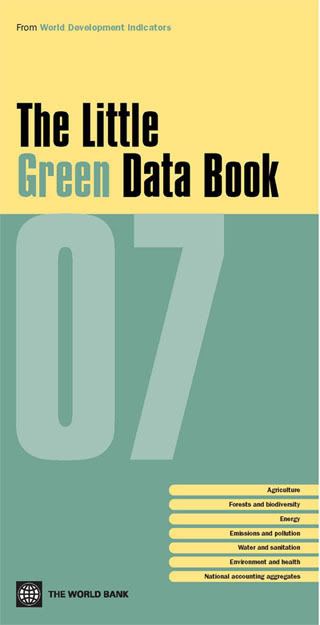 Carbon dioxide (CO2) emissions – the principal man-made cause of global warming – continue to rise, with the world producing today 16 percent more CO2 than in 1990, according to the
Carbon dioxide (CO2) emissions – the principal man-made cause of global warming – continue to rise, with the world producing today 16 percent more CO2 than in 1990, according to the 




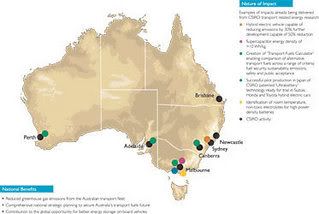
 According to the
According to the  Chevron Energy Solutions, a Chevron subsidiary, today
Chevron Energy Solutions, a Chevron subsidiary, today 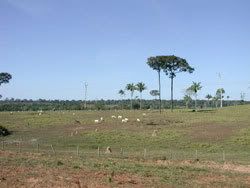

 The worldwide transition to biofuels and bioenergy offers many opportunities, but also involves a number of trade-offs and risks, the United Nations says in its long-awaited and most comprehensive review of the likely impacts of the emerging bioenergy market, which was released today.
The worldwide transition to biofuels and bioenergy offers many opportunities, but also involves a number of trade-offs and risks, the United Nations says in its long-awaited and most comprehensive review of the likely impacts of the emerging bioenergy market, which was released today. As rainfall patterns change due to global warming, tropical plants may acclimate more easily than commonly thought, new research shows. The findings are highly important for countries in the South who are set to become biofuel producers, relying on tropical energy crops, and for the livelihoods of millions of smallholders in the developing world who make a living from agro-forestry.
As rainfall patterns change due to global warming, tropical plants may acclimate more easily than commonly thought, new research shows. The findings are highly important for countries in the South who are set to become biofuel producers, relying on tropical energy crops, and for the livelihoods of millions of smallholders in the developing world who make a living from agro-forestry.
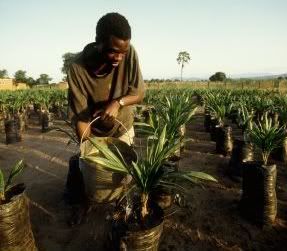 The United Nations Conference on Trade and Development (
The United Nations Conference on Trade and Development ( Distiller’s dried grains (DDGs) are the leftovers from converting corn into fuel ethanol. In the US Midwest alone, ethanol producers generate 10 million tons of DDGs annually. Farmers buy the residue for between US$85 and US$110 per ton and feed it to livestock. The rapidly expanding ethanol market may imply that meat prices will drop because of lower feed prices. This is the case in Europe, where, according to an EU study, the large new stream of biodiesel residues (glycerin) and ethanol byproducts suitable as feed components will result in lower meat prices (
Distiller’s dried grains (DDGs) are the leftovers from converting corn into fuel ethanol. In the US Midwest alone, ethanol producers generate 10 million tons of DDGs annually. Farmers buy the residue for between US$85 and US$110 per ton and feed it to livestock. The rapidly expanding ethanol market may imply that meat prices will drop because of lower feed prices. This is the case in Europe, where, according to an EU study, the large new stream of biodiesel residues (glycerin) and ethanol byproducts suitable as feed components will result in lower meat prices (
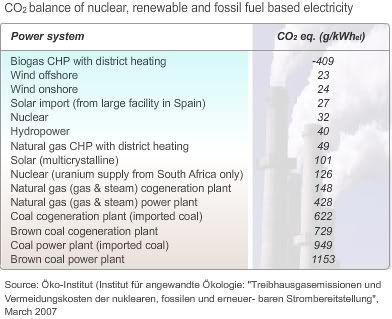


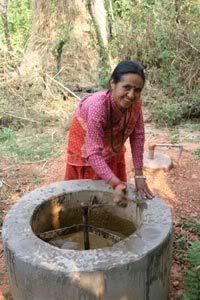 Nepal will receive US$500,000 (33 million rupiah) each year as part of two biogas-related
Nepal will receive US$500,000 (33 million rupiah) each year as part of two biogas-related 






Saturday, May 12, 2007
Researchers develop biomass powered "refrigerator-stove-generator" for developing world
Now wouldn't it be great if you could solve all these problems by creating one single device? Imagine an affordable three-in-one technology that consists of an efficient, low-cost refrigerator, combined with a safe and clean cooking stove, and an electric generator added to it. To make things better, imagine the device being powered by the very biomass rural people in the South already use on a daily basis, albeit in a wasteful manner.
Well, the SCORE project (Stove for Cooking, Refrigeration and Electricity) is developing exactly such a machine. What is more, the device will rely on the physics of thermoacoustic heating and cooling - a field of research that has resulted in such high-tech applications as devices to cool satellites, radars and to liquefy natural gas. The £2 million (€2.93/US$3.96 million) project brings together four major UK universities, the US Los Alamos National Laboratory, a multi-national electrical goods manufacturer, an international charity and numerous universities in Asia and Africa.
The consortium's goal is to reduce poverty in Africa and Asia by understanding the energy needs of rural communities and working with them to develop the affordable, versatile, domestic appliance. The collaboration will ensure the device is affordable, socially acceptable, and there is scope for communities to develop numerous businesses from the manufacture, repair and innovative usage.
Thermoacoustics
The University of Manchester's Dr Artur Jaworski, an expert in thermoacoustic engineering in The School of Mechanical, Aerospace and Civil Engineering, will lead the vital research into the engine design for the SCORE device.
Using thermoacoustic technology is a more efficient way of using wood as a fuel than using an open fire to cook. It produces less pollutants. Like a Stirling engine, the device will also have fewer moving parts than ordinary engines and freezers, making it more reliable. The efficiency of thermoacoustic engines (40%) is considerably higher than that of ordinary combustion engines:
Innovations
The concept of the device is based on the proven thermoacoustic Stirling engines and refrigerators developed by Los Alamos, NASA and the US military for applications including: cooling of satellite systems and radar arrays, gas liquefaction and cryogenics, use of waste heat for air conditioning, separation of binary gas mixtures and many others. There is a significant level of innovation in the proposed work in three respects:
- research into the combination of the thermoacoustic engine, linear alternator and cool box in a single device, powered by a biomass stove, which has not been attempted before
- design of a rugged and inexpensive linear alternator that could be easily mass-produced
- the overall system design from the viewpoint of low cost, application of indigenous materials, use of local manufacturing skills and simplicity of assembly, which are major research issues compared to the high-cost and high-tech thermoacoustic systems produced so far.
These challenges form the backbone of the proposed scientific and technological work programme.Within the overall 5-year duration, there will be two stages to the project: the first 3 years will mainly focus on conducting the necessary social and scientific research, while the last 2 years will broadly focus on technology hand-over, including representative field trials and a wide dissemination among target communities.
Dr Jaworski says: "A multi-purpose thermoacoustic device such as this, powered by biomass, has never been attempted before. Although we have wide experience of this technology and applying it in different ways, this new and exciting project will require plenty of ingenuity and innovation."
Making a difference
"With the depth of experience and expertise we have assembled as part of this international project, we are confident we can meet our aims, deliver a viable appliance and make a real difference to people living in the developing world."
"The benefits could be huge, ranging from better health due to the correct storage of medicines, to improved education through electricity for computers and lighting, to a higher standard of living through the creation of employment opportunities and associated businesses."
Researchers will need to look carefully at ways of ensuring any design can be assembled cheaply and easily using local labour and indigenous materials. Given the high cost and high-tech nature of current thermoacoustic systems, this represents a significant challenge.
Dr Jaworski, who is an EPSRC Advanced Research Fellow, will work closely with academics at The University of Nottingham, Imperial College London and Queen Mary, University of London.
Other partners are the international charity Practical Action, Los Alamos National Laboratory and GP Acoustics. Universities in developing countries in Africa and Asia will also assist with the design, development, production and introduction of the device.
The SCORE consortium is funded by grants from the Engineering and Physical Sciences Research Council (EPSRC) as part of its initiative on energy and international development.
More information:
The SCORE project website.
The Thermoacoustics web-server at the Los Alamos National Laboratory, with an overview of the physics.
Daniel A. Russell and Pontus Weibulla, "Tabletop thermoacoustic refrigerator for demonstrations" [*.pdf], American Association of Physics Teachers, 2002.
Steven L. Garrett, Scott Backhaus, "The Power of Sound", American Scientist, November-December 2000, Volume: 88 Number: 6 Page: 516 DOI: 10.1511/2000.6.516
Article continues
posted by Biopact team at 5:54 PM 3 comments links to this post
